Abstract
Sustainable urban renovation is characterized by multiple factors (e.g., technical, socio-economic, environmental and ethical perspectives), different spatial scales and a number of administrative structures that should address the evaluation of alternative scenarios or solutions. This defines a complex decision problem that includes different stakeholders where several aspects need to be considered simultaneously. In spite of the knowledge and experiences during the recent years, there is a need of methods that lead the decision-making processes. In response, a methodology based on a KPI-driven approach for urban renovation at district level is proposed in the European Smart City project CITyFiED. The methodology is a procedure with the energy efficiency as main pillar and the local authorities as client. It is composed of seven phases that ensures an effective dialogue among all the stakeholders, aiming to understand the objectives and needs of the city to deliver a set of customized Strategies for Sustainable Urban Renovation. In order to provide guidance and quantitative criteria, three levels of indicators are integrated into the approach: City Level Indicators (L1) at city & district level, Project Level KPIs (L2), and Impact Assessment Indicators at city level (L3).
1. Introduction
The increase of the global energy demand occurred during the last decades has been mainly covered using fossil fuels for the energy generation. There is an urgent need to redirect this tendency in order to avoid worst scenarios of climate change. This situation is particularly complex in the case of cities, which have been attracting large population inflows from rural areas and concentrating the main social and economic activities of the world. Nowadays, cities house half of the world’s population but use two-thirds of the world’s energy and generate three-fourths of the world’s CO2 emissions [1]. Their role in addressing climate change is widely accepted as it is highlighted in the Paris Agreement (2016). Moreover, according to the European Commission there is a huge improvement potential linked to the reduction of emissions from houses and office buildings, which could be reduced by around 90% by 2050 [2].
In this regard, urban morphology and the way that the city grows through its districts affects to several aspects of the city like its livability, energy efficiency, etc. [3]. However, there is a direct opportunity linked to the energy related interventions that will be implemented in our cities during the next years, which can guide their transformation towards the desirable low carbon future.
While there are many methodologies, tools, and studies at building level that allow a detailed analysis, the integrated sustainability evaluation at a larger scale, such as the district or the city scale is not so well documented nowadays. This new scope of the analysis offers many opportunities for incorporating bigger shares of renewable energy technologies as well as the use of efficient interventions such as district heating networks. However, it also entails considering aspects that increase the difficulty of the energy planning.
Several initiatives, such as the ‘Joint programme on Smart Cities of the European Energy Research Alliance (EERA, Brussels, Belgium) within the Strategic Energy Technology Plan (SET-Plan) [4], have been emerging during the last years trying to generate knowledge in the field of long-term energy planning of cities. However, there is still a need of standardization of the different methodologies that have to be combined to cover the various dimensions of the analysis. Studies, such as the review conducted by Mirakyan & De Guio (2013) [5] evidence the potential and the necessity of an integrated energy planning for cities.
This paper provides the framework of a methodology capable of evaluating different alternatives for urban renovation at district level following an approach based on Key Performance Indicators that covers a wide perspective and eases the complexity that characterizes sustainable urban renovation. Each of the phases of the methodology and the connections between them are described in the following sections.
2. The CITyFiED Methodology for City Renovation at District Level
The CITyFiED Methodology is a complete and systematic process designed as a consultancy tool for Sustainable Strategic Urban Planning, with the local authorities as clients and the energy efficiency as main pillar. Its objective is to facilitate the decision-making process during the selection of measures to obtain a set of tailored Strategies for Sustainable Urban Renovation.
The methodology is based on a KPI-driven approach for urban renovation at district level, which is integrated along the seven phases of the procedure. Three levels of indicators are defined: City Level Indicators (L1) to understand and diagnose the urban area at city and district scales; Project Level KPIs (L2) to perform the analysis and selection of the solutions; and Impact Assessment Indicators at city and district level (L3) for the final evaluation of results.
2.1. Stakeholders of the Methodology
The Methodology addresses the roles and responsibilities of the stakeholders involved along the application phases. The foresight of an External Consultancy Group (ECG) to closely cooperate with the local authorities is one of the key innovative aspects. This multidisciplinary group collaborates when understanding the city and setting up the most suitable set of strategies for the sustainable renovation, facilitating consequently the decision-making process. The stakeholders are sorted in three different groups as shown in Figure 1.
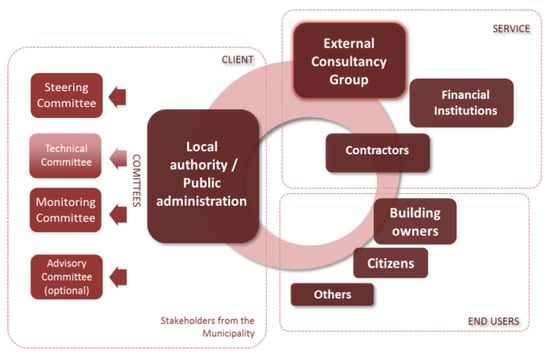
Figure 1.
Stakeholders defined in the Methodology [6].
- Experts representing the Municipality (Client). This group refers to those professionals that are part of the Local Authorities or Public Administration. They are organized in different committees depending on their responsibilities. While politicians or decision makers are included in the Steering Committee, the Technical and Monitoring Committees involve urban planners, technicians, engineers, architects, etc. Finally, politicians or technicians from other Public Administrations levels could provide advice during the process as the Advisory Committee.
- Consultant experts and stakeholders from the building, energy and financial sector (Service). In this category is included the External Consultancy Group (ECG) which consist of technical consultants, technological institutes, research institutions, academia, etc. Their aim is to define the current status of the city, support the measures selection and propose the customized Strategies for Sustainable Urban Renovation. Contracting parties as entities in charge of the realization of works and Financial institutions also cooperate with the Municipality.
- Public participation (End Users). Social aspects have a high relevance in the CITyFiED Methodology. Different techniques are included to allow the collaboration and the participation throughout the different procedures of the Building owners, Neighbors associations, residents, Housing associations, NGOs, etc.
2.2. Phases of the Methodology
The Methodology is deployed in seven phases as can be seen in Figure 2. Each phase ensures an effective dialogue among all the stakeholders and considers ways to strengthen confidence in decision-making processes. It combines both district and city scales, starting with the city and district analysis, proposing initiatives at district level and pursuing the impact of the renovation and the accomplishment with the initial objectives at both scales.
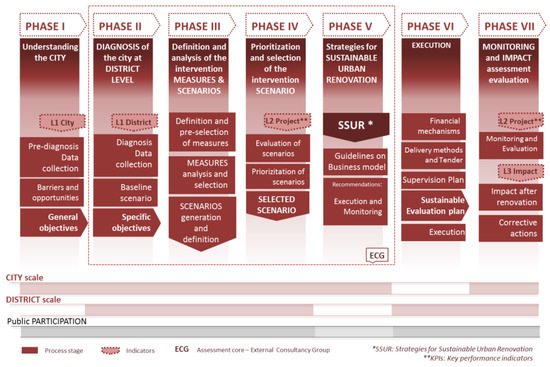
Figure 2.
The CITyFiED Methodology approach [6].
- Phase I: Understanding the city objectivesThis phase makes a first approach to the city understanding, evaluating its context and needs with the City Level Indicators as a supporting tool and taking into account public participation. This analysis, combined with the definition of the long-term city vision, enables the identification of the city sustainable pathway within its Strategic Urban Planning and the definition of the general objectives that guide this transition.
- Phase II: Diagnosis of the city at district levelIn this phase, the city is understood as an aggregation of districts. Taking into account the results in Phase I, the city is analyzed at district level to define the specific objectives for the district/s object of the intervention. Part of the City Level Indicators can be applied in this stage, defining the baseline for the district.
- Phase III: Analysis of the measures and scenariosThe feasibility of the measures to be part of the retrofitting scenarios is analyzed assisted by the External Consultancy Group and according to the objectives at city and district scales set in the previous phases. Energy simulation tools and Project Level KPIs support this study, evaluating the impact of the different Energy Conservation Measures (ECM) in the city and district current status and easing the final selection.
- Phase IV: Prioritization and selection of the intervention scenarioThe objective of this phase is to identify the most convenient solution from the potential scenarios. The External Consultancy Group expertise, Project Level KPIs - applied in this case to the scenarios - and multi-criteria analysis are the basis for the decision-making process. Finally, the discussion is expected to be carried out through an open dialogue and consensus between technicians, citizens and local authorities.
- Phase V: Strategies for Sustainable Urban Renovation (SSUR)The measures of the selected scenario are further developed as strategies tailored to the city in Phase V according to its initial objectives. In addition, other considerations are included, i.e., citizen engagement, non-technological barriers overcoming or business model identification. The final aim of this phase is the definition of the Strategies for Sustainable Urban Renovation (SSUR); a customized plan integrated within the Strategic Urban Planning of the city.
- Phase VI: Execution planThe implementation plan to put into practice the strategies defined in the SSUR is defined. Other recommendations are included to be applied during Phase VI and Phase VII related to the delivery methods, technical definition, commissioning or monitoring, among others. In this phase, different Contracting parties as contractors, suppliers, energy companies, ESCos, etc. are involved.
- Phase VII: Monitoring and impact assessment evaluationThe objective of this phase is to evaluate and monitor the strategies implemented during the previous phase; assess the final sustainable impact at district and city levels; and deploy corrective actions from the short to the long term implementation and also for future renovation actions. In this stage, Project Level KPIs are used to assess the scenario performance with data from monitoring, while Impact Assessment Indicators at city level evaluates the results achieved.
3. Key Performance Indicators (KPIs) to Facilitate the Decision Process
3.1. Evolution of Key Performance Indicators Definition
In recent years, several indicator frameworks for the performance measurement of urban systems have been developed within the European Framework programs FP6, FP7, and H2020. The aim of these indicator frameworks is to create an extensive data resource to provide information and evidence on which to base decision-making and policy making.
Several projects have appeared related to the Key Performance Indicators definition. The most remarkable are SCIs [7], CITYKeys [8] and CONCERTO. Funded by the European Union H2020 Programme, the aim of CITYKeys is to develop and validate, with the aid of cities, Key Performance Indicators and data collection procedures for the common and transparent monitoring; as well as the comparability of smart city solutions across European cities. It is hoped to be the most remarkable framework for monitoring and comparing the implementation of Smart City Solutions in the near future. Because of these reasons, is pleasant to know that CITYKeys has developed some issues in a similar way as CITyFiED:
- CONCERTO as main source of CITYKeys for key performance indicator definition: CONCERTO was an initiative within the European Research Framework Programme (FP6 and FP7) which aims to demonstrate that the optimization of the building sector of whole communities is more efficient and less expensive than each building individually.
- Similar strategic areas: Both projects, CITyFiED and CITYKeys, divide in five groups the strategic areas of the KPI at city level (Figure 3).
 Figure 3. CITyFiED and CITYKeys Strategic Areas [6].
Figure 3. CITyFiED and CITYKeys Strategic Areas [6].
On the other hand, The Smart Cities Information System (SCIS) brings together project developers, cities, institutions, industry and experts from across Europe to exchange data, experience and know-how, and to collaborate on the creation of smart cities and an energy-efficient urban environment. SCIS encompasses data collected from ongoing and future projects under the CONCERTO initiative and Smart Cities calls in FP7 and H2020.
CITyFiED KPIs results will be compared with Technical Monitoring Database & Visualization of CONCERTO Premium; the results of the three demo sites will feed SCIS to contribute in supporting replication of smart cities innovation and technologies.
3.2. CITyFiED Key Performance Indicators (KPIs) for District Renovation
In order to achieve an understanding and to improve the energy performance of the European building sector, CITyFiED is proposing an innovative methodology for city renovation at district level, based on the use of Key Performance Indicators (KPIs).
The definition of a set of KPIs is a crucial factor to evaluate the success of the retrofitting processes. These indicators refer to the data types that are measured or estimated in relation to a defined measurement boundary for calculating and verifying the impact of the retrofitting interventions and cover energy, comfort and environmental technical aspects in a quantifiable manner together with economic, social and urban conditions.
Under this context, three levels of indicators have been defined (Figure 4): Level 1 corresponds to City Level Indicators, whereas Levels 2 and 3 correspond to Project Level Indicators and Impact Assessment Indicators, respectively.

Figure 4.
Integration of the three levels of indicators in the Methodology application.
3.2.1. City Level Indicators (L1)
Level 1 or City Level Indicators at city & district level aim to evaluate the sustainability standards, identify city’s strengths and weaknesses, and help setting general and specific objectives for the city during Phases I and II of the Methodology.
They are defined according to the considered application areas and strategic areas (as can be seen in Figure 5):
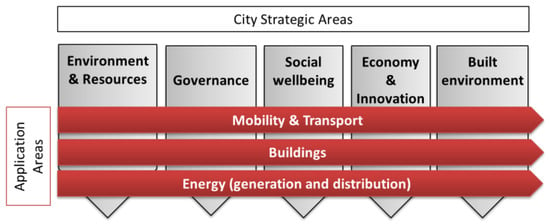
Figure 5.
Level 1 indicators matrix: City Strategic Areas and Application Areas [6].
- City strategic areas: Environment & Resources (ER), Governance (GO), Social Wellbeing (SW), Economy & Innovation (EI) and Built Environment (BE).
- City application areas: Mobility & Transport (MT), Buildings (BU), Energy (EN).
The indicators were defined under CONCERTO Premium Initiative [9], the standard UNE-EN ISO 37120, PLEEC project, ASCE, Special Plan of Sustainable KPIs for the City of Seville, International Energy Agency (IEA), etc. They have been selected in order to complete de city analysis, and also to identify the general and specific objectives of the city or district. Furthermore, an internal validation activity was developed by the three demonstration cases of the CITyFiED project [10] to refine them: the municipalities of Lund (Sweden), Laguna de Duero (Spain) and Soma and Manisa (Turkey).
Last but not least, reference values of Level 1 indicators have been identified, in order to compare the indicators calculated for the city analysis with reference values of European cities.
3.2.2. Project Level KPIs (L2)
Level 2 or Project Level KPIs serve as a tool for a detailed evaluation in order to determine the most relevant factors affecting the state and performance of a district, as well as to evaluate the actions that correspond to the objectives previously set for the whole city.
Therefore, Level 2 or Project Level KPIs as a tool could be used in two stages of the CITyFiED Methodology:
- Definition and analysis of the intervention and scenarios (Phases III and IV): During this stage, Project Level KPIs are calculated using Energy Simulation software tools in order to provide results to allow obtaining an accurate estimation of the energy performance and other aspects of a building or a group of buildings or district.
- Evaluation phase: During this stage, Phase VII, Level 2 indicators are calculated through real data from monitoring.
Project Level KPIs were defined under CONCERTO Premium Initiative [9], the Intergovernmental Panel on Climate Change (IPCC), the Ecoinvent centre, the EU BaaS project and the standard UNE-EN ISO 7730 [10].
The selected Project Level KPIs have been classified in 4 area: Social, Environmental (E), Technical (T) and Economic indicators (Ec) (see Figure 6). They will be calculated for each demo site of the CITyFiED project and will enable to achieve a more accurate knowledge to improve the decision-making process as well as to transfer the CITyFiED project results into the technical database of SCIS.
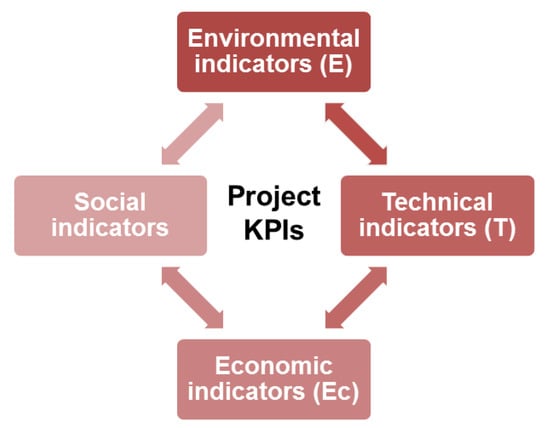
Figure 6.
Areas of evaluation of measures and scenarios through Project Level Indicators.
3.2.3. Impact Assessment Indicators at City Level (L3)
Level 3 indicators were defined for impact assessment of retrofitting actions, because they were proposed to be calculated in order to evaluate the impact of the measures and projects deployed in the districts.
The types of impacts that are going to be quantified through the Level 3 indicators calculation will cover the following categories (see Figure 7): Energy, Environment, Employment, Economic, and Benefits for SMEs, being the specific result expected for each category as described below:
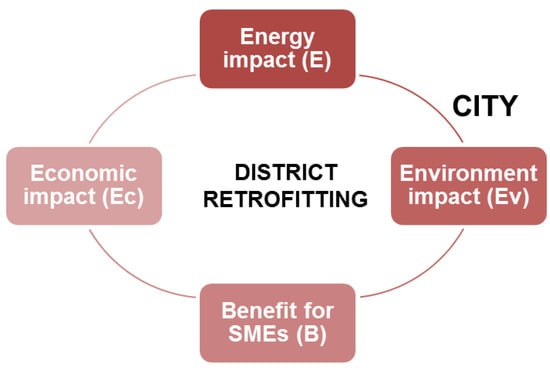
Figure 7.
Type of impacts evaluated in the assessment indicators.
- Energy impact (E): Energy savings obtained with district retrofitting intervention.
- Environment impact (Ev): Estimations on CO2 emissions avoided with the intervention.
- Economic impact (Ec): It covers the investment mobilized and its return to the users, companies and municipalities as well as benefits of retrofitting to the users associated to the cost savings.
- Benefits for SMEs (B): It consists in all repercussions of investment made in the demosites and in the companies as business generated and market competitiveness for SMEs involved in retrofitting process. There are also evaluated the number of new types of high-skilled jobs and new curricula developed by the project, or the possible Spin-offs and Start-ups created as result of the CITyFiED project.
4. Conclusions
This Methodology is a holistic procedure for the city renovation at district level that considers a multi-criteria perspective. The integration of the three levels of KPIs supports the diagnosis, selection as well as final evaluation of measures and retrofitting scenarios during the project, serving as a control and decision-making tool.
The CITyFiED project aims to enable the replicability and mass-market deployment of energy-efficient retrofit of districts. The approach and the indicators were conceived and are being refined considering as a reference the large CITyFiED demonstration cases in the cities of Lund (Sweden), Laguna de Duero (Spain) and Soma (Turkey), including decision-making processes and business models. The approach is also being validated through the active participation of the CITyFiED network of cities, assuring its flexibility and adaptability to different European cities.
Author Contributions
The CITyFiED Methodology was conceived through a collaborative work between CARTIF Foundation, TECNALIA Research and Innovation and ACCIONA Construcción. As written contributions for this article, Eneko Arrizabalaga analyzed the background; Estefanía Vallejo, Ali Vasallo and Miguel Á. García-Fuentes presented the KPIs; and Cristina Criado defined the methodology approach and coordinated the content.
Acknowledgments
This project has received funding from the European Union’s Seventh Programme for research, technological development and demonstration under grant agreement N° 609129. The authors would like to thank the rest of the partners of the CITyFiED project for their help and support.
Conflicts of Interest
The authors declare no conflict of interest.
References
- Smart Cities Council. Smart Cities Readiness Guide. The Planning Manual for Building Tomorrow’s Cities Today; EEUU: Seattle, WA, USA, 2013. [Google Scholar]
- European Commission. COM/2011/0112 final. Communication from the Commission to the European Parliament, the Council, the European Economic and Social Committee and the Committee of the regions. In A Roadmap for Moving to a Competitive Low Carbon Economy in 2050; European Commission: Brussels, Belgium, 2011. [Google Scholar]
- PACT Research Project. Available online: http://www.projectpact.eu/ (accessed on 5 June 2017).
- Joint Programme on Smart Cities of the European Energy Research Alliance (EERA) within the Strategic Energy Technology Plan (SET-Plan). Available online: http://www.eera-sc.eu/ (accessed on 8 June 2016).
- Mirakyan, A.; De Guio, R. Integrated energy planning in cities and territories: A review of methods and tools. Renew. Sustain. Energy Rev. 2013, 22, 289–297. [Google Scholar] [CrossRef]
- Smart City Information System. Available online: http://smartcities-infosystem.eu/ (accessed on 4 June 2017).
- CITYkeys Project. Available online: http://www.citykeys-project.eu (accessed on 6 June 2017).
- Stengel, J. CONCERTO Premium. Indicator Guide; Version 4; European Union: Brussels, Belgium, 2012. [Google Scholar]
- CITyFiED Project. Available online: http://www.cityfied.eu/ (accessed on 3 June 2017).
- UNE-EN ISO 7730. Thermal Comfort Conditions. Available online: http://www.insht.es/InshtWeb/Contenidos/Documentacion/TextosOnline/GuiasMonitor/Ergonomia/X/Ficheros/ex08.pdf (accessed on 7 June 2017).
Publisher’s Note: MDPI stays neutral with regard to jurisdictional claims in published maps and institutional affiliations. |
© 2018 by the authors. Licensee MDPI, Basel, Switzerland. This article is an open access article distributed under the terms and conditions of the Creative Commons Attribution (CC BY) license (https://creativecommons.org/licenses/by/4.0/).